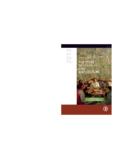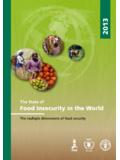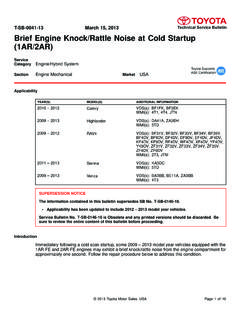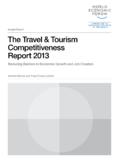Transcription of Education at a Glance 2013 - OECD.org
1 2013 Education at a Glance 2013 OECD inDiCatOrsEducation at a Glance2013 OECD inDiCatOrsthe statistical data for israel are supplied by and under the responsibility of the relevant israeli authorities. the use of such data by the OECD is without prejudice to the status of the Golan Heights, East Jerusalem and israeli settlements in the West Bank under the terms of international credits: stocklib image Bank Cathy Feng YuGetty images blue jean images OECD 2013 You can copy, download or print OECD content for your own use, and you can include excerpts from OECD publications, databases and multimedia products in your own documents, presentations, blogs, websites and teaching materials, provided that suitable acknowledgement of OECD as source and copyright owner is given.
2 All requests for public or commercial use and translation rights should be submitted to requests for permission to photocopy portions of this material for public or commercial use shall be addressed directly to the Copyright Clearance Center (CCC) at or the Centre fran ais d exploitation du droit de copie (CFC) at work is published on the responsibility of the secretary-General of the OECD. the opinions expressed and arguments employed herein do not necessarily reflect the official views of the Organisation or of the governments of its member document and any map included herein are without prejudice to the status of or sovereignty over any territory, to the delimitation of international frontiers and boundaries and to the name of any territory, city or cite this publication as: OECD ( 2013 ), Education at a Glance 2013 .
3 OECD Indicators, OECD 978-92-64-20104-0 (print)isBn 978-92-64-20105-7 (PDF) Education at a Glance 2013 : OECD Indicators OECD 20133 ForewordGovernments are paying increasing attention to international comparisons as they search for effective policies that enhance individuals social and economic prospects, provide incentives for greater efficiency in schooling, and help to mobilise resources to meet rising demands. As part of its response, the OECD Directorate for Education and Skills devotes a major effort to the development and analysis of the quantitative, internationally comparable indicators that it publishes annually in Education at a Glance .
4 These indicators enable educational policy makers and practitioners alike to see their Education systems in light of other countries performance and, together with the OECD country policy reviews, are designed to support and review the efforts that governments are making towards policy at a Glance addresses the needs of a range of users, from governments seeking to learn policy lessons to academics requiring data for further analysis to the general public wanting to monitor how its country s schools are progressing in producing world-class students.
5 The publication examines the quality of learning outcomes, the policy levers and contextual factors that shape these outcomes, and the broader private and social returns that accrue to investments in at a Glance is the product of a long-standing, collaborative effort between OECD governments, the experts and institutions working within the framework of the OECD Indicators of Education Systems (INES) programme and the OECD Secretariat. The publication was prepared by the staff of the Innovation and Measuring Progress Division of the OECD Directorate for Education and Skills, under the responsibility of Dirk Van Damme and Corinne Heckmann and in co-operation with Etienne Albiser, Simone Bloem, Rodrigo Castaneda-Valle, Eric Charbonnier, Estelle Herbaut, Karinne Logez, Koji Miyamoto, Joris Ranchin, Cuauhtemoc Rebolledo-Gomez, Gara Rojas Gonz lez, David Valenciano, and Jean Yip.
6 Administrative support was provided by Rhodia Diallo, editing of the report was undertaken by Marilyn Achiron, and additional advice as well as analytical and editorial support were provided by Gwenaelle Barach, Marika Boiron, C lia Braga-Schich, Elizabeth Del Bourgo, Caroline Isra l, Diane Lalancette and Ignacio Marin. The authoring team benefited from the analytical review of Sam Abrams, Francesco Avvisati, Tracey Burns, Sonia Guerriero, Hiroko Ikesako, David Istance, Marco Kools, Katarzyna Kubacka, Pauline Musset, Anna Pons, Miho Taguma, Willam Thorn, Juliana Zapata and Pablo Zoido.
7 Production of the report was co-ordinated by Elisabeth Villoutreix. The development of the publication was steered by member countries through the INES Working Party and facilitated by the INES Networks. The members of the various bodies as well as the individual experts who have contributed to this publication and to OECD INES more generally are listed at the end of the much progress has been accomplished in recent years, member countries and the OECD continue to strive to strengthen the link between policy needs and the best available internationally comparable data.
8 This presents various challenges and trade-offs. First, the indicators need to respond to educational issues that are high on national policy agendas, and where the international comparative perspective can offer important added value to what can be accomplished through national analysis and evaluation. Second, while the indicators should be as comparable as possible, they also need to be as country-specific as is necessary to allow for historical, systemic and cultural differences between countries. Third, the indicators need to be presented in as straightforward a manner as possible, while remaining sufficiently complex to reflect multi-faceted educational realities.
9 Fourth, there is a general desire to keep the indicator set as small as possible, but it needs to be large enough to be useful to policy makers across countries that face different educational at a Glance 2013 : OECD Indicators OECD 20134 The OECD will continue to address these challenges vigorously and to pursue not just the development of indicators in areas where it is feasible and promising to develop data, but also to advance in areas where a considerable investment still needs to be made in conceptual work.
10 The further development of the OECD Programme for International Student Assessment (PISA) and its extension through the OECD Survey of Adult Skills, a product of the Programme for the International Assessment of Adult Competencies (PIAAC), as well as the OECD Teaching and Learning International Survey (TALIS), are major efforts to this at a Glance 2013 : OECD Indicators OECD 20135 Table of ContentsNumber of the indicator in the 2012 editionEditorial ..13 Introduction ..17 Reader s Guide ..21 Chapter a the output of eduCational institutions and the impaCt of learning.

















